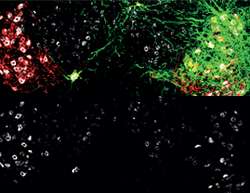Protecting neurons in neurodegenerative disease

(Medical Xpress)—Neurobiologist from the Friedrich Miescher Institute for Biomedical Research proved that excitability protects motoneurons from degeneration in amyotropic lateral sclerosis, a rare neurodegenerative disease. By modulating excitability they could influence the rate of motor dysfunction and muscle denervation, and slow the progression rate of the disease. This is important because it points to a possible way to delay the progression of this so far incurable disease. Their results are published online in Neuron.
Neurodegenerative diseases start silently. For years, the disease causes damage, while the nervous system compensates and adapts, keeping up a semblance of normalcy. By the time the symptoms appear and the patient seeks the advice of a physician, it is no longer clear what changes in the nervous system were caused by the disease, what by compensation. This has hampered progress in understanding of neurodegenerative disorders for decades. Only recently scientists have obtained the scientific tools to map and influence the disease processes in detail and in time. No wonder that with these new tools longstanding hypotheses around neurodegenerative diseases start to collapse.
Pico Caroni, group leader at the Friedrich Miescher Institute for Biomedical Research, is one of the pioneers looking into specific dysfunctions and corresponding adaptive processes in the brain during early phases of neurodegenerative diseases. He and his team are investigating causes and consequences of amyotropic lateral sclerosis (ALS), a rare, incurable neurodegenerative disease that can be modeled in mice. ALS patients suffer from progressive and irreversible damage to their motor neurons, the neurons controlling muscles and thus movement and ultimately die within 3 to 5 years of diagnosis.
In a study published in Neuron today, Caroni and his team could show that the widely accepted hypothesis that too much excitation is toxic to ALS neurons and thus causes dysfunction and denervation, is actually wrong. Excitability is indeed elevated early in disease, but this process is in fact adaptive. In a mouse model of inherited ALS (FALS) they could show that the neurons first to degenerate are the ones that exhibit the lowest excitability. In these cells the effect of the mutant protein that is linked to the disease, SOD1, is most pronounced. A higher excitability protected the other motoneurons for a while until they succumbed too, in the order of their level of excitability.
Based on these findings the scientists then specifically enhanced excitability in the neurons that were most susceptible using novel genetic tools. They could show that this protected the motoneurons from degeneration, slowed the accumulation of the misfolded protein SOD1, reversed the pathology and extended life. Conversely, decreased excitability exacerbated the disease. Finally, they were able to identify an intracellular mediator that brings about the protection of motoneurons, mTOR. As the scientists modulated mTOR levels through its inhibitor rapamycin, more misfolded SOD1 accumulated and motor dysfunction was more pronounced.
"In our study we could show that excitability is indeed important in ALS, but in a totally different way than initially thought", said Caroni, "A greater excitability was compensatory and augmented neuroprotection. Focusing on adaptive, in this case neuroprotective, processes in the nervous system early during the disease proved to be a valuable approach to unravel causes and consequences of the disease. Since clinical data from ALS patients parallels the findings that the disease progresses along the different vulnerabilities of low- and high-excitability motoneurons, we think that our findings may also prove helpful for the development of novel therapeutic strategies."
More information: Saxena, S., et al. (2013) Neuroprotection through excitability and mTor required in ALS motoneurons to delay disease and extend survival, Neuron, Sept. www.cell.com/neuron/abstract/S0896-6273(13)00651-X
















